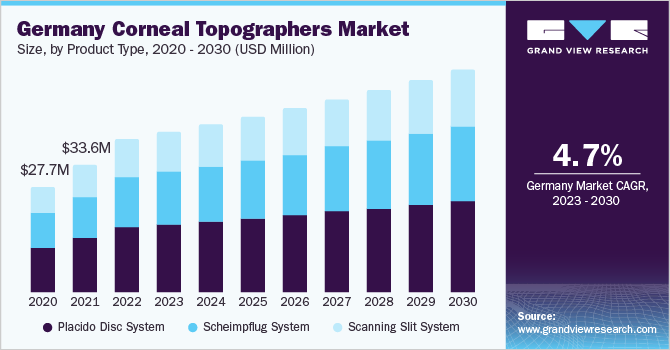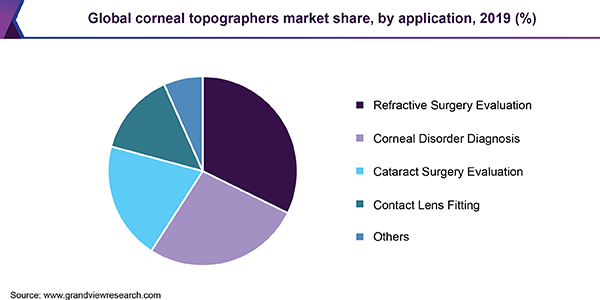
Corneal Topographers Market Size, Share & Trends Analysis Report By Product Type (Placido Disc System, Scanning Slit System, Scheimpflug System), By Application, By End Use, By Region, And Segment Forecasts, 2020 - 2027
- Report ID: GVR-4-68038-192-4
- Number of Pages: 120
- Format: Electronic (PDF)
- Historical Range: 2016 - 2018
- Industry:Healthcare
Report Overview
The global corneal topographers market was valued at USD 631.1 million in 2019 and is projected to witness a CAGR of 4.8% during the forecast period. Major factors driving the market for corneal topographers include increasing prevalence and incidence of age-associated ophthalmic conditions coupled with the rising number of government initiatives to create awareness for early detection, prevention, and treatment of these conditions. For instance, in July 2016, the Indian State government under the coverage of Rashtriya Swasthya Bima Yojna (RSBY) offered free eye surgeries at state medical colleges and hospitals. This led to steep growth in ophthalmic surgery volume in the country.
Moreover, increasing focus of market players on research and development and high engagement in strategic collaborations to develop innovative ophthalmic diagnostic modalities are the factors expected to be affirmative growth indicators. However, post-surgical complications caused due to ophthalmic interventions are expected to restrain the growth of the market for corneal topographers.

The integration of novel diagnostic modalities for screening and early detection of ophthalmic conditions including cataracts is expected to bolster the demand for corneal topographers. According to the facts stated by the World Health Organization, October 2019, around 2.2 billion people were affected with vision impairment or blindness worldwide, of which at least 1 billion people had unaddressed or preventable conditions.
The Vision Loss Expert Group, in 2017 stated that blindness or vision impairment was majorly due to refractive error- 12%, cataract 6.3%, glaucoma (0.7%), corneal opacities (0.4%), diabetic retinopathy 0.3%, and trachoma 0.2%. Presbyopia accounted for 80.1% of the total unaddressed cases.
Furthermore, increasing the volume of surgical procedures in different healthcare settings including hospitals, clinics, and ambulatory care centers is expected to augment the demand for advanced corneal topographers. According to the survey undertaken by Refractive Surgery Council, around 843,000 vision correction procedures such as LASIK, PRK, and SMILE were performed in the U.S. in 2018, representing an overall increase of 6.2% as compared to 2017.
Moreover, the rising focus of government and non-government organizations for the prevention and elimination of preventable ophthalmic conditions is expected to create a lucrative opportunity in the market for corneal topographers. The National Keratoconus Foundation (NKCF) aims to enhance the awareness and knowledge of corneal surface disorders such as keratoconus. NKCF is also focused on supporting scientific research for effective diagnosis and treatment of keratoconus.
Furthermore, in 2013, the Universal Eye Health: Global Action Plan (GAP) 2014-2019, was adopted by the Member States at the World Health Assembly. The GAP plans to provide universal access to the patients by offering comprehensive eye care services and curb disease burden. The International Agency for the Prevention of Blindness, states that GAP aims to minimize the prevalence of preventable visual impairment by 25% by 2019, as compared to 2010.
The increasing availability of affordable treatment options, availability of skilled professionals, and the growing adoption of novel technologies by patients are the factors acceleratingmedical tourismin developing economies such as Malaysia, India, and China. This is expected to create huge demand for corneal topographers in the Asia Pacific.
Product Type Insights
Based on product type, the corneal topographers market is segmented into Placido disc system, Scheimpflug systems, and scanning slit system. Placido disc system accounted for the largest market share as these discs are among the firstly available technologies for corneal topographers. The system enhances corneal disease monitoring and facilitates early diagnosis as compared to alternative screening modalities such as keratometry. The systems are used for a wide range of applications to improve the practitioner's understanding related to corneal shape. They are important in diagnosing conditions such as keratoconus, pellucid marginal dystrophy, contact lens practice, orthokeratology, refractive surgery patient management, intraocular lens (IOL) calculation, and post keratoplasty.
The Scheimpflug system segment is expected to exhibit the fastest growth rate in the market for corneal topographers during the forecast period. The advantages of Scheimpflug imaging include high cornea resolution, measuring corneas with severe irregularities, such as keratoconus, ability to calculate pachymetry. The device also offers corneal wavefront analysis for the detection of higher-order aberrations.
End-use Insights
Based on end-use, the market for corneal topographers is segmented into hospitals, ophthalmic clinics, and ambulatory surgical centers. The ambulatory surgical centers (ASC) segment is expected to be the fastest growing segment in the market for corneal topographers during the forecast period. This can be attributable to increasing surgical interventions carried out in the ASCs as compared to hospital settings owing to low-cost surgeries, easy access, and convenience for elder and the disabled population is expected to accelerate the growth rate of ASCs over the forecast period.
According to the article published by the researchers at the University of Michigan, 2017, in the U.S. around 73% of cataract surgeries were performed in ASCs in 2014, whereas only 43.6% surgeries were performed in 2001. Moreover, the ASCs segment is the fastest growing segment in the market for corneal topographers. This is owing to lower out of pocket costs, as stated by researchers from the University of Michigan, where a shift from hospital outpatient department to ASCs saved an average cataract co-pay of US$ 160.
因此,具有成本效益的、高效和先进的ophthalmic services offered by the ASCs are thereby increasing the preference of the patient population to undergo medical procedures at the facilities.
Application Insights
Based on applications, the market for corneal topographers is segmented into corneal disorder diagnosis, cataract surgery evaluation, refractive surgery evaluation,contact lensfitting, and others. Refractive surgery evaluation accounted for the dominant share in the market for corneal topographers in 2019. The dominance is mainly attributed to factors such as a higher prevalence of patients diagnosed with refractive errors such as myopia (near-sightedness), hyperopia (farsightedness), astigmatism (distorted vision at all distances), and presbyopia.

Moreover, the corneal disorder diagnosis segment is expected to grow at a lucrative rate in the market for corneal topographers during the forecast period. The high growth rate of the segment is primarily attributed to the use of corneal topographers for the detection and treatment of keratoconus, Fuchs’ endothelial dystrophy, and bullous keratopathy. According to the Eye Bank Association of America, keratoconus is a major corneal disorder affecting one in every 2,000 individuals in the U.S. Thus, high-risk factors of the condition, resulting in irregular astigmatism, myopia and visual impairment are expected to augment the demand for corneal topographers in ophthalmic settings.
Regional Insights
Regionally, the market for corneal topographers is segmented into North America, Latin America, Europe, Asia Pacific, and Middle East and Africa. North America dominated the market for corneal topographers in 2019 owing to factors such as favorable reimbursement and government and non-government initiatives to boost research and innovation. For instance, in June 2016, Research to Prevent Blindness (RPB) granted funds of US$ 5.4 Mn for 17 ophthalmic departments and 19 scientists to support eye research.
In addition to the age-related cataract, increasing cases of congenital cataracts is expected to favor the growth of the market for corneal topographers. According to the statistics published by Research to Prevent Blindness, 2014, approximately 1,200-1,600 infants are diagnosed with congenital cataracts annually in the U.S.
Moreover, increasing the preference of ophthalmologists to opt for private-pay models provides the freedom to the physicians to invest in new screening technology. In July 2019, the Centers for Medicare and Medicaid Services (CMS) decreased reimbursement rates for cataract surgeries by 15%.
In the Asia Pacific, the market for corneal topographers is expected to grow at a lucrative rate in the market for corneal topographers over the forecast period. The high growth rate in the region is primarily attributed to factors such as the rise in the influx of international patients to Asian countries offering affordable treatment, increasing penetration of market players in the developing countries, and government initiatives supporting the ophthalmic care. The Indian National Programme for Control of Blindness and Visual Impairment was launched to create awareness and provide comprehensive eye care services for cataract, refractive errors, corneal disorders, and glaucoma. In addition, medical tourists are driven by several factors such as favorable exchange rates and quality care at an affordable cost.
Corneal Topographers Market Share Insights
The leading players present in the market for corneal topographers include Carl Zeiss AG, OCULUS Optikgeräte GmbH, Cassini Technologies, Nidek Co., Ltd., Tomey Corporation, EyeSys Vision, Tracey Technologies, and Topcon Corporation.
New product launches, distribution agreements, and product innovation are the major strategies adopted by the market players to retain their share in the market for corneal topographers. Integration of advanced ophthalmic devices to boost efficiency and to reduce overall price is trending in recent years. In August 2018, OCULUS Pentacam AXL was linked to the IOLcompass Pro Guidance system from Leica Microsystems and TrueVision’s TruePlan, to provide boost efficiency in cataract precision surgery.
Report Scope
Attribute |
Details |
Base year for estimation |
2019 |
Actual estimates/Historical data |
2016 - 2018 |
Forecast period |
2020 - 2027 |
Market representation |
Revenue in USD Million and CAGR from 2020 to 2027 |
Regional scope |
North America, Europe, Asia Pacific, Latin America, Middle East & Africa |
Country scope |
U.S., Canada, U.K., Germany, France, Italy, Spain, Russia, Japan, China, Malaysia, India, South Korea, Thailand, Brazil, Mexico, Argentina, Columbia, South Africa, Saudi Arabia, UAE, Qatar |
Report coverage |
Revenue forecast, company share, competitive landscape, growth factors, and trends |
15% free customization scope (equivalent to 5 analysts working days) |
If you need specific information, which is not currently within the scope of the report, we will provide it to you as a part of customization |
Segments Covered in the Report
This report forecasts revenue growth at global, regional, and country levels as well as provides an analysis of the latest industry trends in each of the sub-segments from 2016 to 2027. For the purpose of this study, Grand View Research has segmented the global corneal topographers market report on the basis of product type, application, end use, and region.
Product Type Outlook (Revenue, USD Million, 2016 - 2027)
Placido Disc System
Scheimpflug System
Scanning Slit System
Application Outlook (Revenue, USD Million, 2016 - 2027)
Cataract Surgery Evaluation
Corneal Disorder Diagnosis
Refractive Surgery Evaluation
Contact Lens Fitting
Others
End-use Outlook (Revenue, USD Million, 2016 - 2027)
Hospitals
Ophthalmic Clinics
Ambulatory Surgical Centers
Regional Outlook (Revenue, USD Million, 2016 - 2027)
North America
U.S.
Canada
Europe
U.K
Germany
France
Italy
Spain
Russia
Asia Pacific
Japan
China
India
Thailand
Malaysia
South Korea
Latin America
Brazil
墨西哥
Argentina
Columbia
Middle East & Africa
South Africa
Saudi Arabia
UAE
Qatar
Frequently Asked Questions About This Report
b.The global corneal topographers market size was estimated at USD 631.1 million in 2019 and is expected to reach USD 660 million in 2020.
b.The global corneal topographers market is expected to grow at a compound annual growth rate of 4.8% from 2020 to 2027 to reach USD 915.6 million by 2027.
b.北美主导角膜地形学者market with a share of 40.1% in 2019. This is attributable to favorable reimbursement and government and non-government initiatives to boost research and innovation.
b.Some key players operating in the corneal topographers market include Carl Zeiss AG, OCULUS Optikgeräte GmbH, Cassini Technologies, Nidek Co., Ltd., Tomey Corporation, EyeSys Vision, Tracey Technologies, and Topcon Corporation.
b.Key factors that are driving the market growth include increasing volume of surgical procedures, the surge in medical tourism, increasing prevalence of ophthalmic conditions and high engagement in strategic collaborations to develop innovative ophthalmic diagnostic modalities.





